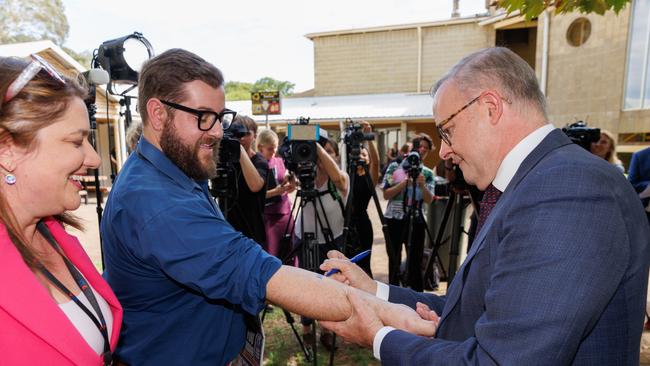Matt Cunningham: Anthony Albanese’s GST pledge in WA could impact NT
Anyone who has been watching the deterioration in the social fabric of the NT would know, this is no laughing matter, writes Matt Cunningham.
News
Don't miss out on the headlines from News. Followed categories will be added to My News.
Prime Minister Anthony Albanese signed a pledge on the arm of a journalist in Perth this week vowing he would keep the Coalition’s sweetheart GST deal that sees a great share of funding distributed to Western Australia.
It was all very funny and everyone had a good laugh as Albo told the journalist – a former Labor staffer – that he should get the pledge inked in a tattoo.
But this little stunt could have serious ramifications for the Northern Territory.
The GST has traditionally been carved up under a system known as horizontal fiscal equalisation.
Put simply, it means the national GST pool is distributed between the states and territories on the basis of need.
Remoteness, disadvantage and indigeneity are all considered when the Commonwealth Grants Commission decides how much money goes where.
But in 2018, the Turnbull Government made changes that significantly increased WA’s share. At the time the state’s resources industry was stalling.
It’s booming again now but Albanese, under pressure to hold marginal Perth seats at the next federal election, says the deal will stay.
Economists including Saul Eslake and Chris Richardson say the deal could cost $50 billion over the next decade.
That money, of course, has to come from somewhere.
And while a “no worse-off deal” has been locked in for other states and territories until 2030, when the day of reckoning arrives, the NT could be in the line of fire.
The Territory, of course, is not in a strong bargaining position when it comes to arguing for a greater share of GST.
In 2022/23 the NT received a relative share of $4.87 per dollar contributed.
Western Australia received 70 cents.

But, as the Yothu Yindi foundation argues in its latest submission to the productivity commission, the funding is failing to address the massive infrastructure deficit suffered in remote parts of the Territory.
“This model is designed to keep a jurisdiction ‘as is’, and does not provide the means for a state or territory to take steps to deal with fundamental deficits that impair economic development and service delivery.”
The simple solution would be to drastically increase the NT’s share of GST funding.
We know, however, that this would be problematic. GST funding is untied, meaning state and territory governments are free to spend it as they choose.
And the NT Government has developed a hard-to-kick habit of taking this money – obtained on the basis of remote Indigenous disadvantage – and spending it on shiny new things in the city.
We saw a prime example this week when Infrastructure Minister Joel Bowden called a press conference to show off the new development of Liberty Square, right at the foot of Parliament House.
At a cost of more than $4 million, the government has dug up a perfectly good “green space” and will replace parts of it with decking, concrete and car parks, all in the name of creating a “green space”.
Just a few hours after the press conference Labor Senator Malarndirri McCarthy posted pictures to Facebook of the appalling state of the Carpentaria “Highway”, which has been closed due to flooding.
The timing was no doubt by accident rather than design, but it was a glaring example of the funding distortions that have long seen remote Territorians crying foul.
Here was a government doing a massive blitz of its own backyard while a major remote arterial road had been reduced to a muddy impassable swamp.
The best defence the minister could muster was that the Liberty Square project was “creating” 20 jobs.
But jobs are created by fostering private investment, not by distributing public money.
And it’s our government’s failure to do this that has left us so dependent on GST funding.
The Yothu Yindi submission notes that our urban-heavy electoral system and bloated public service – based mainly in Darwin and Alice Springs, means there is no political incentive to do anything differently.
“The inevitable impact of these distortions is that funds which are sent to the Territory based on disadvantage are redirected for urban or other political priorities,” the submission says.
“Lack of transparency and accountability mechanisms to judge the efficiency compounds the problems. It’s a system which traps Aboriginal people in an endless cycle of deficit and despair, as the worse the disadvantage, the more untied GST funds are sent to the Territory. So rather than incentivising economic development and growth, the GST model incentivises disadvantage and a focus on maximising GST payments. There is no penalty for failing to address disadvantage, only reward.”
The GST needs a serious overhaul.
That should probably see more funding sent to the NT.
But those funds need to be tied to place and need.
And as anyone who has been watching the deterioration in the social fabric of the NT would know, this is no laughing matter.
More Coverage
Originally published as Matt Cunningham: Anthony Albanese’s GST pledge in WA could impact NT





